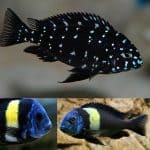
If you are considering bringing a Duboisi cichlid home, you may be wondering how to best care for them. First, you should know that these mouth brooders are extremely slow growing and require a species-specific aquarium. In addition, they are also susceptible to disease and require a slow growing tank to keep them healthy.
Contents
Tropheus duboisi cichlids are mouth brooders
Tropheus duboisi – also known as the Duboisi cichlid – is an attractive and unique species of cichlid that originated in the rocky coastal waters of northern Lake Tanganyika, Africa. As a mouth brooder, they are best kept in large groups of six or more. They grow to maturity to a beautiful blue colour, with a wide yellow band behind their pectoral fins. This species does best in an aquarium designed specifically for its species.
Female Tropheus duboisi dabs can carry a brood of 5-15 eggs for up to four weeks, during which she will continue to feed. It is important to keep a close eye on a female Tropheus fish during this time, as she may discard her brood prematurely if she is overly stressed. During this time, it is best to avoid moving the female Tropheus duboisi from its tank. If this occurs, the female will lose her position in the pecking order and may be viciously attacked by other males.
Tropheus duboisi dabs are mouth brooders and are very easy to breed. They are easily purchased as singles or in small groups. Once mature, they pair up and form a harem. The female will lay eggs in rocky areas. The female will then scoop the fertilised eggs into her mouth. The fry take up to 30 days to hatch. Premature release of fry can result in the fry dying.
They require a species-specific aquarium
Duboisi cichlid species require a species-specific aquarium to survive. Their aggressive nature and active lifestyle require a large tank with strong filtration and significant water movement. The water must be hard alkaline and oxygenated, with a stable pH and nitrate levels. They do well in large colonies of at least 10 individuals.
The aquarium should be at least 55 gallons in size, preferably a 75 gallon tank. It is important to maintain proper pH and alkalinity levels and do a biweekly water change. The substrate should be African cichlid-specific or marine Aragonite, as these substrates will effectively buffer pH and alkalinity.
The Duboisi cichlid is a slow-growing species, taking several years to reach sexual maturity. Males are typically larger and have more pronounced lobes on their heads. Females, on the other hand, have smaller lobes and are generally lighter-colored. It is important to keep at least five to six females with one male in order to maximize breeding potential.
They are susceptible to disease
The Duboisi cichlid is a slow growing species that may take several years to reach sexual maturity. Males are larger than females and have a more prominent upturned nose. They are also lighter in color and may be thinner. Females should be kept with one or two males to maximize breeding potential. Due to their aggressive behavior, you should avoid keeping them with other species that are passive. It is also important to maintain a low water hardness level in the tank and change the water frequently.
The Duboisi cichlid is endemic to the lake of Tanganyika. These fish reach 12 cm in length. Their diet consists primarily of algae mats. They also ingest sediments. These cichlids are known to be susceptible to disease.
Duboisi cichlid populations should be kept in groups of at least six fish. They will fight among themselves. Therefore, it is best to keep them in a tank of at least six fish. They can be kept with other semi-aggressive fish. As omnivores, they feed off the bacteria and algae in the aufwuchs. They can easily get sick if their water is too acidic.
They have a slow growth rate
Duboisi cichlid are a relatively slow-growing species and may take many years to reach sexual maturity. The males are much larger than the females and have a more pronounced, upturned nose. Females are often lighter in color and much smaller in size. As a result, it is recommended to keep as many females as possible with a single male in your tank, in order to maximize the breeding potential of your fish.
Duboisi cichlid care requires attention to several important details. First of all, proper water quality is important. You need to perform regular partial water changes. It is also important to remove uneaten food to prevent disease. Depending on your stocking numbers, it is recommended to perform at least a 30% water change weekly.
Duboisi cichlid species should be kept in large groups of at least six. They are most likely to do well with other semi-aggressive fish.

